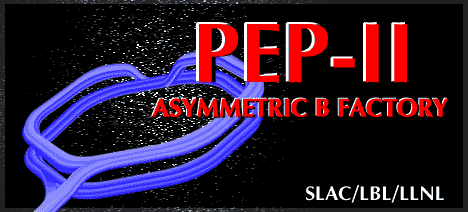 02/10/99 Update
02/10/99 Update
 02/10/99 Update
02/10/99 Update
During the past week PEP-II commissioning has concentrated on raising the LER beam current, stabilizing the HER beam at 500 mA, and raising the luminosity.
In raising the LER current we observe nonlinear pressure increases in the straight sections starting at about 400 to 500 mA. The vacuum and current signatures match reasonably well electron multipactoring as calculated by a one dimensional model. Distributing the beam current over more bunches seems to help. About a week ago, at high current an aperture restriction suddenly occurred in a straight section. We vented and found a 1 mm glow discharge wire (2 m long) which had been inadvertently left behind on the chamber floor. The LER beam lifetime has reached 60 minutes at 600 mA but is still 240 minutes at low currents. A peak current of 771 mA was achieved in the LER Monday with 786 bunches (every 4th bucket with a 10% gap).
The HER team has been working on the feedback systems and the longitudinal low mode "woofer link" to stabilize the bunches. These systems are all now working for both rings.
We have just completed a five day collision run. By last Saturday we had gotten to 1.8x10**32 luminosity in the standard tune location. With small local tune adjustments a luminosity of 2.8x10**32 was achieved by Sunday morning. We tried a new tune location for the LER on Sunday night. After small tune adjustments (0.01) and with nux = 0.62 (fraction) and ny = 0.57, we reached 4.3x10**32/cm**2/sec in 786 bunches with currents of 676 mA in LER and 273 mA in HER. By Monday night we achieved our present luminosity peak of 5.2 x 10**32/cm**2/sec with 786 bunches and 680 mA in the LER and 354 mA in the HER. The cap-sigmas (sqrt( sum of the beam sizes squared)) from beam-beam scans are 11 to 12 microns in the vertical and about 200 microns in the horizontal. We also collided 1571 bunches with the design bunch spacing (every second bucket with a 10% gap) and obtained 3.0 x 10**32 with 678 mA on 439 mA. With 1571 bunches the parasitic crossing effects increase the transverse bunch stability significantly, even when the bunches are separated at the collision point.
We have about two more weeks of running before the BaBar roll-on starts February 22.
Congratulations to all for breaking a luminosity of 5 x 10**32 and thanks again.
John Seeman 2/10/99
Suggestions to: John Seeman
[PEP-II Commissioning Updates] [PEP-II Home Page] [BABAR Detector Home Page] [SLAC Home Page]
Page owner: achan